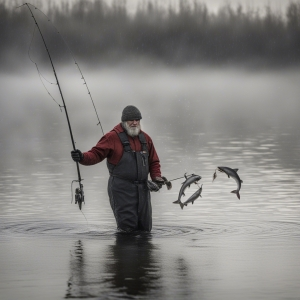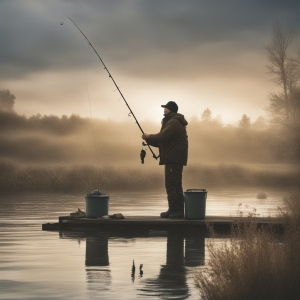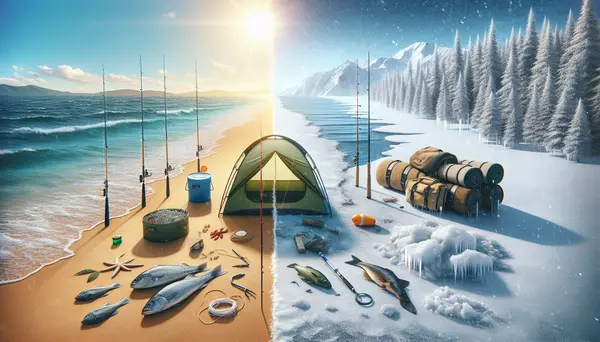Table of Contents:
Introduction to Fishing in Different Climates
If you're an aspiring angler or an old hand at fishing, understanding how different conditions affect fish behavior can be quite a game-changer. Welcome to this thorough guide on fishing in different climates. Not only will you acquire tips on how to fish in various weather conditions, but you'll also understand how to enhance your overall angling skills. From hot tropical climates to freezing cold waters, we've got the information that'll help you reel in a successful catch no matter the thermostat reading.
Understanding Climate Impact on Fishing
Before dipping your fishing rod into the water, it's important to consider the climate and weather. You might wonder, why does climate matter in fishing? Here's the reason: climate affects fish behaviors drastically. For example, fish feeding habits alter in high and low temperature. Understanding this opens up the possibility of more catches and, indeed, more fun while fishing.
Comparison of Fishing Strategies in Hot and Cold Climates
| Factors | Hot Climate | Cold Climate |
|---|---|---|
| Best Time to Fish | Early Morning or Late Evening | Afternoon when temperature is highest |
| Preferred Bait | Live Bait (insects, worms) | Artificial Bait (jigs, spoons) |
| Species Availability | Bass, Catfish, Crappie | Trout, Salmon, Pike |
| Weather Impact | Highly influential - Fish are less active in high heat | Less influential - Fish are active under the ice |
| Equipment Recommendation | Lightweight gear, sun protection | Insulated clothing, ice fishing gear |
Strategies for Successful Fishing in Hot Climates

Fishing in hot climates comes with its challenges, so you'll need to adjust your techniques for success. The heat affects fish behavior, so understanding this can prep you for a great catch. One critical strategy is early morning or late evening fishing. These times offer cooler temperatures, making fish more active and likely to bite.
Another good technique is to aim for the deeper waters. In hot environments, larger fish tend to stay deeper to avoid high temperatures. Therefore, target deeper spots in the water bodies for such fish species. Remember, the type of bait you use also matters. The rule of the thumb in hot climates: use natural bait. The more your bait matches the local diet of the fish species, the better your chances.
Another unique aspect of hot climate fishing is the importance of shade. Yes, fish also need a break from the scorching sun. Any shaded areas might be a potential hotspot for catching fish. Always pack plenty of water and wear protective gear to protect you from potential heat hazards.
Tips for Fishing Success in Cold Climates
When it comes to cold weather fishing, you need to be as prepared as much as possible for success. Fish become less active in cold waters and as such, adopting the right strategies is essential. Let’s dive into some handy tips:
First, consider the time of day! Unlike fishing in hot climates, midday is usually the most productive time to fish in colder climates. The reason is simple - it's usually the warmest period of the day, and fish, favoring those warmer temperatures, tend to be more active.
Second, slow down your fishing techniques. Fish metabolism slows down in colder weather, causing them to be less active and slower to take the bait. Use slow moving baits to increase your chances of catching fish.
Third, focus on the depth. Fish respond to cold weather by moving to deeper, warmer waters. Hence, focusing your fishing efforts on deeper waters can prove fruitful.
Finally, investing in quality cold-weather gear is a must. Dress in layers and ensure you have the right equipment handle the cold weather.
Taking into consideration these tips, you’re sure to enjoy your fishing expedition, regardless of the icy conditions.
Thriving as an Angler in Varied Weather Conditions

Fishing successfully across different climates needs a mastery of fishing skills and a keen understanding of fish behavior. If the weather is hot, fishing at the coolest times of the day, using natural bait, and trying areas of shade can enhance your chances of hooking fish.
On the flip side, in a colder climate, fishing during the warmest part of the day, slowing down your reeling methods, and focusing on deeper waters can put you on track for a fruitful fishing experience. Safety should also be of utmost concern: Protective wear in hot climates and layered warm gear in cold ones can be a life saver. Switching between these tactics seamlessly is what differentiates an average angler from a pro. It involves a mixture of skill, understanding, and adaptation, but it's not unattainable. Start applying these tips and soon, you'll be the one sharing advice on how to fish well in any climate!
Conclusion: Conquering Climate in Fishing
To wrap up, successful angling is not ruled by weather but by understanding and adjusting to it. Whether you're handling the searing sun or the biting frost, being aware of your approach can make the difference between empty hooks and a bountiful catch. Remember, it's not about the perfection of the weather, but the skill of the angler. With a bit of practice and adaptation, you'll find yourself conquering any climate that comes your way, emerging victorious with a rewarding fishing story to share. Happy fishing!
Mastering the Elements: A Guide to Fishing in Varied Climates

How does climate impact fishing success?
The climate plays a crucial role in determining the type of fish present in an area, their feeding habits and breeding patterns. Understanding these patterns allows for a more successful fishing experience.
What are the best practices for fishing in hot climates?
In hot climates, it's best to fish early in the morning or late in the evening when temperatures are cooler. Also, using bait and lures that are native to the hot climate will increase your success rate.
What strategies work best for cold climate fishing?
Fishing under the ice is a common strategy in cold climates. Also, using live bait can be beneficial as fish in colder climates tend to be less aggressive and more attracted to natural food sources.
How can I prepare for fishing in varying climates?
Research the climate and fish species in your chosen location. Dress appropriately for the weather, and always have a variety of bait and lures to match the local habitat.
What gear is essential for fishing in different climates?
The right fishing rod, reels, lines, hooks, and bait are crucial. In colder climates, you might require additional gear like ice augers for ice fishing and appropriate clothing to stay warm.







